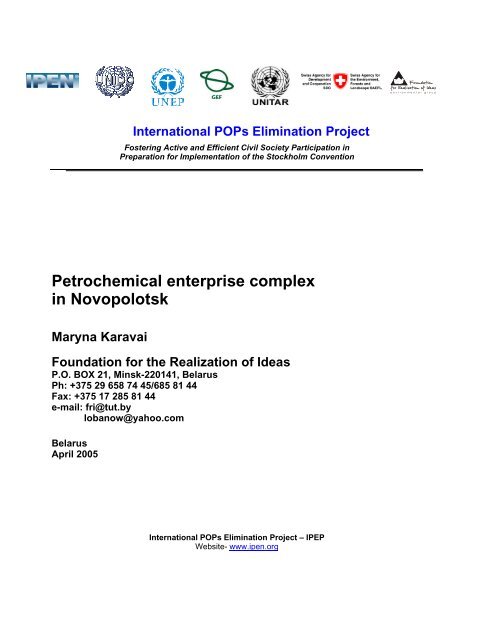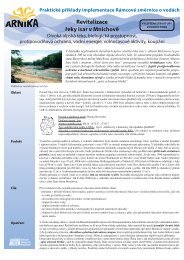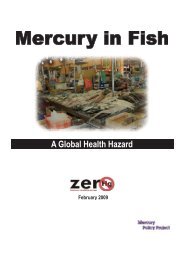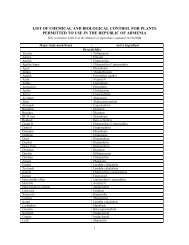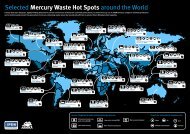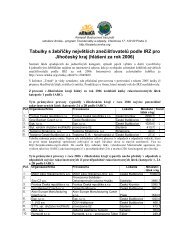Petrochemical enterprise complex in Novopolotsk - International ...
Petrochemical enterprise complex in Novopolotsk - International ...
Petrochemical enterprise complex in Novopolotsk - International ...
You also want an ePaper? Increase the reach of your titles
YUMPU automatically turns print PDFs into web optimized ePapers that Google loves.
<strong>International</strong> POPs Elim<strong>in</strong>ation Project<br />
Foster<strong>in</strong>g Active and Efficient Civil Society Participation <strong>in</strong><br />
Preparation for Implementation of the Stockholm Convention<br />
<strong>Petrochemical</strong> <strong>enterprise</strong> <strong>complex</strong><br />
<strong>in</strong> <strong>Novopolotsk</strong><br />
Maryna Karavai<br />
Foundation for the Realization of Ideas<br />
P.O. BOX 21, M<strong>in</strong>sk-220141, Belarus<br />
Ph: +375 29 658 74 45/685 81 44<br />
Fax: +375 17 285 81 44<br />
e-mail: fri@tut.by<br />
lobanow@yahoo.com<br />
Belarus<br />
April 2005<br />
<strong>International</strong> POPs Elim<strong>in</strong>ation Project – IPEP<br />
Website- www.ipen.org
About the <strong>International</strong> POPs Elim<strong>in</strong>ation Project<br />
On May 1, 2004, the <strong>International</strong> POPs Elim<strong>in</strong>ation Network (IPEN http://www.ipen.org)<br />
began a global NGO project called the <strong>International</strong> POPs Elim<strong>in</strong>ation Project (IPEP) <strong>in</strong><br />
partnership with the United Nations Industrial Development Organization (UNIDO) and the<br />
United Nations Environment Program (UNEP). The Global Environment Facility (GEF)<br />
provided core fund<strong>in</strong>g for the project.<br />
IPEP has three pr<strong>in</strong>cipal objectives:<br />
• Encourage and enable NGOs <strong>in</strong> 40 develop<strong>in</strong>g and transitional countries to engage<br />
<strong>in</strong> activities that provide concrete and immediate contributions to country efforts <strong>in</strong><br />
prepar<strong>in</strong>g for the implementation of the Stockholm Convention;<br />
• Enhance the skills and knowledge of NGOs to help build their capacity as effective<br />
stakeholders <strong>in</strong> the Convention implementation process;<br />
• Help establish regional and national NGO coord<strong>in</strong>ation and capacity <strong>in</strong> all regions<br />
of the world <strong>in</strong> support of longer term efforts to achieve chemical safety.<br />
IPEP will support preparation of reports on country situation, hotspots, policy briefs, and regional<br />
activities. Three pr<strong>in</strong>cipal types of activities will be supported by IPEP: participation <strong>in</strong> the<br />
National Implementation Plan, tra<strong>in</strong><strong>in</strong>g and awareness workshops, and public <strong>in</strong>formation and<br />
awareness campaigns.<br />
For more <strong>in</strong>formation, please see http://www.ipen.org<br />
IPEN gratefully acknowledges the f<strong>in</strong>ancial support of the Global Environment Facility, Swiss<br />
Agency for Development and Cooperation, Swiss Agency for the Environment Forests and<br />
Landscape, the Canada POPs Fund, the Dutch M<strong>in</strong>istry of Hous<strong>in</strong>g, Spatial Plann<strong>in</strong>g and the<br />
Environment (VROM), Mitchell Kapor Foundation, Sigrid Raus<strong>in</strong>g Trust, New York<br />
Community Trust and others.<br />
The views expressed <strong>in</strong> this report are those of the authors and not necessarily the views of the<br />
<strong>in</strong>stitutions provid<strong>in</strong>g management and/or f<strong>in</strong>ancial support.<br />
This report is available <strong>in</strong> the follow<strong>in</strong>g languages: English language, Russian language<br />
<strong>International</strong> POPs Elim<strong>in</strong>ation Project – IPEP<br />
Website - www.ipen.org<br />
1
Table of Contents:<br />
Introduction .................................................................................................................................. 3<br />
Physical description of site ........................................................................................................... 3<br />
History of site ............................................................................................................................... 3<br />
Production association Polymir .................................................................................................... 3<br />
Polymir list of products ................................................................................................................ 4<br />
Production association “NAFTAN" .............................................................................................. 4<br />
Chemical characterization ............................................................................................................. 4<br />
Environmental, Socioeconomic, and Health Consequences ......................................................... 6<br />
Responsible party .......................................................................................................................... 6<br />
Plans for cleanup ........................................................................................................................... 6<br />
Recommendations of NGO ........................................................................................................... 7<br />
2
Introduction<br />
An <strong>in</strong>ventory of diox<strong>in</strong>s and furan sources has not yet<br />
been made <strong>in</strong> Belarus, but accord<strong>in</strong>g to data from<br />
National Academy of Sciences of Belarus and<br />
environmental NGOs, the chemical <strong>in</strong>dustry is<br />
among the major sources of diox<strong>in</strong>s, furans and other<br />
unwanted persistent organic pollutants (POPs).<br />
Industrial processes with<strong>in</strong> the chemical <strong>in</strong>dustry are<br />
undoubtedly one of the ma<strong>in</strong> sources of PCDDs,<br />
PCDFs and Hexachlorobenzene <strong>in</strong> Belarus.<br />
The amount of diox<strong>in</strong> released by <strong>in</strong>dustrial<br />
processes has not been estimated and PCDD/Fs and<br />
HCB and other POPs are not even <strong>in</strong>cluded <strong>in</strong>to the<br />
system of national monitor<strong>in</strong>g due to the lack of<br />
technical and f<strong>in</strong>ancial resources.<br />
Diox<strong>in</strong>s are the un<strong>in</strong>tended by-products of many<br />
chemical and combustion processes <strong>in</strong>volv<strong>in</strong>g<br />
chlor<strong>in</strong>e. They are emitted <strong>in</strong>to the environment via<br />
<strong>in</strong>dustrial air emissions, wastewater discharges,<br />
disposal activities, and burn<strong>in</strong>g materials and<br />
products conta<strong>in</strong><strong>in</strong>g chlor<strong>in</strong>e.<br />
Petroleum manufactur<strong>in</strong>g (oil and gas ref<strong>in</strong><strong>in</strong>g) uses<br />
and mobilizes chlor<strong>in</strong>e <strong>in</strong> multifaceted process<br />
systems that comb<strong>in</strong>e it with petrochemicals,<br />
catalysts and heat. Of the <strong>in</strong>dustries known to<br />
generate diox<strong>in</strong>, oil and gas ref<strong>in</strong><strong>in</strong>g is the largest, by<br />
mass of material produced, <strong>in</strong> the world. All ref<strong>in</strong>ery<br />
processes (reform<strong>in</strong>g, crack<strong>in</strong>g and oil-fired<br />
boilers/furnaces) have tested positive for diox<strong>in</strong> and<br />
the evidence suggests the production of diox<strong>in</strong>-like<br />
PCBs by the <strong>in</strong>dustry.<br />
Diox<strong>in</strong>s form when carbon deposits are burned off<br />
plat<strong>in</strong>um and rhenium used <strong>in</strong> reform<strong>in</strong>g <strong>in</strong> order to<br />
allow reuse of these expensive metal catalysts, a<br />
process called "regeneration." The reform<strong>in</strong>g<br />
process is used by ref<strong>in</strong>eries to rearrange the<br />
structure of partially processed petroleum molecules<br />
to make high-value fuels. Chlor<strong>in</strong>ated solvents are<br />
added. We can therefore assume that this process<br />
can generate significant amounts of diox<strong>in</strong>s.<br />
The polymers produc<strong>in</strong>g <strong>in</strong>dustry is also a<br />
presumptive source of diox<strong>in</strong>s because of the<br />
presence of chlor<strong>in</strong>e <strong>in</strong> the process.<br />
This report provides data available on the<br />
<strong>in</strong>terrelation between chemical <strong>in</strong>dustry and<br />
presumptive diox<strong>in</strong> sources.<br />
<strong>Novopolotsk</strong> city is the location of two ma<strong>in</strong><br />
<strong>enterprise</strong>s of the Belarusian chemical <strong>in</strong>dustry.<br />
Accord<strong>in</strong>g to the official statistic, <strong>Novopolotsk</strong> is the<br />
second most polluted city <strong>in</strong> Belarus after M<strong>in</strong>sk,<br />
3<br />
which has the unenviable dist<strong>in</strong>ction of hav<strong>in</strong>g the<br />
most polluted atmosphere <strong>in</strong> the country.<br />
A worry<strong>in</strong>g factor <strong>in</strong> the M<strong>in</strong>sk pollution situation is<br />
(as already mentioned) the amount of diox<strong>in</strong> released<br />
has not been estimated and the ref<strong>in</strong>ery <strong>in</strong>dustry is<br />
likely to be a major source of diox<strong>in</strong>s <strong>in</strong> Belarus.<br />
Physical description of site<br />
Type of site: petrochemical <strong>enterprise</strong> <strong>complex</strong>. The<br />
ref<strong>in</strong>ery and chemical <strong>complex</strong> of Naftan and<br />
Polymir cover an area of more than 1700 hectares<br />
and is situated 10 kilometers from <strong>Novopolotsk</strong> city,<br />
Vitebsk region, <strong>in</strong> the Northern-Western part of<br />
Belarus. Its geographical locationis: 55 o 32 N, 28 o<br />
39 E.<br />
The surround<strong>in</strong>g landscape is typical of the Northern<br />
part of Belarus. It’s a medium-cont<strong>in</strong>ental woodland<br />
countryside which could be described as a “lakeglacial<br />
landscape” with coniferous, fir, and birch<br />
woods. The soil is ma<strong>in</strong>ly sod-podzol, waterlogged <strong>in</strong><br />
places with scattered areas of common sands.<br />
The Ref<strong>in</strong>ery and Chemical <strong>complex</strong> of Naftan and<br />
Polymir is situated on the river Western Dv<strong>in</strong>a. The<br />
pluvial water outlets from the territory of the<br />
“Naftan” <strong>enterprise</strong> go <strong>in</strong>to the river Uszacza which<br />
flows <strong>in</strong>to the river Western Dv<strong>in</strong>a.<br />
History of site<br />
In 1958 the foundations were laid for the build<strong>in</strong>g of<br />
a new town, <strong>Novopolotsk</strong>, whose population grew<br />
quickly with the construction of the two largest<br />
Ref<strong>in</strong>ery and Chemical <strong>complex</strong>es <strong>in</strong> Europe.<br />
Accord<strong>in</strong>g to official statistic <strong>Novopolotsk</strong> is<br />
considered as one of the most polluted cities <strong>in</strong> the<br />
Republic of Belarus.<br />
Production association Polymir<br />
At present JSC "Polymir" is one of the largest<br />
chemical plants of the Belarus state concern,<br />
"Belneftechim".<br />
A <strong>complex</strong> consist<strong>in</strong>g of 5 plants with 30 ma<strong>in</strong> and<br />
auxiliary plants cover<strong>in</strong>g 800 hectares, the site<br />
employs 6.000 specialists. The base of the <strong>enterprise</strong><br />
technology is hydrocarbon feed crack<strong>in</strong>g of the petrol<br />
and light hydrocarbons of the ref<strong>in</strong>eries and gas<br />
plants. The technology <strong>in</strong>cludes multi-staged<br />
process<strong>in</strong>g of pyrolysis hydrocarbon cuts and mak<strong>in</strong>g<br />
f<strong>in</strong>al products.
Annual foreign trade turnover is about 200 million<br />
USD.<br />
"Polymir” began its operations <strong>in</strong> 1968. The ma<strong>in</strong><br />
raw material is naphtha or light hydrocarbons of<br />
the gas and oil process<strong>in</strong>g plants. Polymir produce<br />
annually the follow<strong>in</strong>g products: more than<br />
100.000 t of low density polyethylene and<br />
composition on its basis, 70.000 t of acrylic fibers,<br />
100.000 t of monomers (acrylonitrile, acetone<br />
cyanohydr<strong>in</strong>, methylacrylate, acetonitrile), 20.000 t<br />
of small-scale chemistry (polyethylene waxes,<br />
emulsions, pigment superconcentrates, Lanspolymer-polyoil,<br />
Vodam<strong>in</strong>-115-polyamide res<strong>in</strong>,<br />
lfhangas coorosion <strong>in</strong>hibitor and others).<br />
Polymir list of products<br />
Low density polyethylene: basic grades and<br />
compositions on its basic.<br />
Acrylic fiber: Nitron -C, Nitron -D, Nitron -M.<br />
Products of organic synthesis: acrylonitrile,<br />
acetonitrile, acetone cyanohydr<strong>in</strong> and methylacrylate.<br />
Small-scale chemistry: polyethylene waxes,<br />
emulsions, pipes, pigment superconcentrates,<br />
ammonium sulphate, sorbent – carrier, concentrate<br />
of lubricat<strong>in</strong>g – cool<strong>in</strong>g liquid, silicasol, lans<br />
polyester res<strong>in</strong>, vodam<strong>in</strong> polyamide res<strong>in</strong>, ifhangas<br />
corrosion <strong>in</strong>hibitor, sorbitan C, sorbital C-20.<br />
Hydrocarbon fractions: hydrostabilized pyrocondensate,<br />
fraction C9, fraction C4, propane<br />
fraction, heavy pyrolisis res<strong>in</strong>.<br />
Consumer goods: film, covers, knitted goods, yarn.<br />
Production association<br />
“NAFTAN"<br />
The Ref<strong>in</strong><strong>in</strong>g JSC Naftan was built upon <strong>in</strong> 1968.<br />
The potential crude oil ref<strong>in</strong>ery capacity of Naftan<br />
Ref<strong>in</strong>ery accounts for 12-15 millions tons a year. In<br />
2002 the unitary <strong>enterprise</strong> was reorganized as<br />
jo<strong>in</strong>-stock Company. Major company products are:<br />
• Fuels: high duty gasol<strong>in</strong>e and<br />
environmentally-friendly, diesel fuel, jet fuel,<br />
residual oil, kerosene.<br />
• Lube oils and additives to lube oils:<br />
motor, transmission, hydraulic, compressor,<br />
<strong>in</strong>dustrial oils.<br />
4<br />
• Aromatics: benzene, toluene, paraxylene,<br />
orthoxylene, pseudocumene.<br />
• As well as: solvents, sulfuric acid,<br />
bitumens and other products – <strong>in</strong> all more than<br />
70 denom<strong>in</strong>ations.<br />
Chemical characterization<br />
As already mentioned accord<strong>in</strong>g to official statistic<br />
<strong>Novopolotsk</strong> is considered as one of the most<br />
polluted cities <strong>in</strong> the Republic of Belarus. It is<br />
estimated the quantity of pollutants per citizen <strong>in</strong><br />
2001 from stationary sources averaged 499<br />
kilograms.<br />
The chemical compounds found <strong>in</strong> the atmosphere<br />
accord<strong>in</strong>g to the official statistics <strong>in</strong>clude: carbolic<br />
acid, ammonia, benzapilene, carbon dioxide,<br />
formaldehyde, sulfur dioxide, toluol, acetone, benzol,<br />
methyl acrylate, acrylonitrile, hydrogen cyanide,<br />
hydrogen sulphide, nitrogen dioxide and others.<br />
The follow<strong>in</strong>g chemical compounds present <strong>in</strong> the<br />
water (accord<strong>in</strong>g to the official statistics) <strong>in</strong>clude:<br />
ammonia nitrogen, nitrite nitrogen, nitrate nitrogen,<br />
phosphates, iron, copper, z<strong>in</strong>c, nickel, manganese, oil<br />
products, tamol, phenol, molybdenum, chromium,<br />
cyanides, thiocyanates, ammonia, silicic acid and<br />
others.<br />
In accordance with the official statistics the quantity<br />
the amounts of the chemical agents exposed <strong>in</strong> the<br />
water stays with<strong>in</strong> the legal limits.<br />
Results obta<strong>in</strong>ed of the monitor<strong>in</strong>g conducted by one<br />
NGO provide evidence that the water quality of the<br />
river Western Dv<strong>in</strong>a does not come up to the<br />
requested standards for the water bodies of cultural,<br />
welfare, and fish <strong>in</strong>dustry purposes. The<br />
concentration of oil products <strong>in</strong> the river Western<br />
Dv<strong>in</strong>a exceeded maximum permissible concentration<br />
(MPC) for the water bodies of cultural, welfare, and<br />
fish <strong>in</strong>dustry purposes (mg/liter). Ammonia nitrogen<br />
content <strong>in</strong> the river Western Dv<strong>in</strong>a also exceeds the<br />
maximum permissible concentration (MPC) for the<br />
water bodies of cultural, welfare, and fish <strong>in</strong>dustry<br />
purposes before and after the manufactur<strong>in</strong>g water<br />
diversion po<strong>in</strong>t.<br />
This is evidence of pollution of the river caused by<br />
manufactur<strong>in</strong>g water and sewage diversion plus other<br />
factors.<br />
Effluent discharge from “Naftan” and “Polimir” and<br />
other <strong>enterprise</strong>s <strong>in</strong>to the river Western Dv<strong>in</strong>a <strong>in</strong> the<br />
area of the <strong>Novopolotsk</strong> city is a source of high<br />
concentration of pollutants, <strong>in</strong> particular the
concentration of ammonia nitrogen, oil production,<br />
nitrates, quantity of suspended substances and<br />
common m<strong>in</strong>eralization. The qualitative analysis of<br />
water from the river Uszacza revealed a number of<br />
organic pollutants, <strong>in</strong>clud<strong>in</strong>g some standardized by<br />
national legislation such as phenol and its<br />
compounds, benzaldehyde, am<strong>in</strong>es, sylphonols<br />
(polyphenols), pipered<strong>in</strong>e, benzoic acid, derivative<br />
substances of benzol) as well as some not<br />
standardized such as polyaromatic hydrocarbons,<br />
nitriles, biphenyl, diisoctyladipate).<br />
The concern “Naftan” is a large-scale petroleum<br />
ref<strong>in</strong>ery <strong>enterprise</strong>. Types and concentration of<br />
pollutants <strong>in</strong> sewage from such <strong>enterprise</strong>s depends<br />
on the quality of oil, the quality of oil process<strong>in</strong>g,<br />
technique <strong>in</strong> catalyst operation etc. <strong>in</strong> compliance<br />
with reference data on oil products, phenols,<br />
ammonia nitrogen, tamol chlorides, toluol,<br />
trisodium phosphate and others. Types and<br />
concentration of pollutants <strong>in</strong> sewage from<br />
<strong>enterprise</strong>s produc<strong>in</strong>g plastic is determ<strong>in</strong>ed by the<br />
eng<strong>in</strong>eer<strong>in</strong>g process and quality of the <strong>in</strong>itial store,<br />
raw materials and treat<strong>in</strong>g chemicals. On the<br />
production of ethylene some aromatic<br />
hydrocarbons, polypropylene, isopropyl alcohol,<br />
alum<strong>in</strong>um, titanium, chlorides, sulphates (and<br />
others) are found.<br />
Unfortunately there is no data available on the<br />
effluent discharges of JSC "Polymir".<br />
The production process of polyv<strong>in</strong>yl chloride (PVC),<br />
and the associated production of chlor<strong>in</strong>e, ethylene<br />
dichloride and v<strong>in</strong>yl chloride monomer – from<br />
chlor<strong>in</strong>e to f<strong>in</strong>ished product – is known to produce<br />
highly diox<strong>in</strong>-enriched wastes, while PVC products<br />
are among the world’s largest s<strong>in</strong>gle causes of diox<strong>in</strong><br />
formation.<br />
There have been many examples of highly diox<strong>in</strong>contam<strong>in</strong>ated<br />
wastes from EDC/VCM/PVC plants.<br />
For example, <strong>in</strong> 1995 the European V<strong>in</strong>yls<br />
Corporation Wilhelmshaven plant <strong>in</strong> Germany found<br />
huge levels of diox<strong>in</strong>s (up to 700,000 ng ITEQ m-3)<br />
<strong>in</strong> diox<strong>in</strong> analyses of sludge samples from the waste<br />
treatment plant.<br />
PVC <strong>in</strong>volves the formation and release of diox<strong>in</strong>s<br />
dur<strong>in</strong>g its production and manufacture, use and<br />
ultimate disposal. Industry sources have described<br />
diox<strong>in</strong> formation as unavoidable dur<strong>in</strong>g the process<br />
of PVC manufacture. Diox<strong>in</strong>s have been found <strong>in</strong> the<br />
major PVC precursor, ethylene dichloride (EDC) and<br />
are found <strong>in</strong> EDC/v<strong>in</strong>yl chloride monomer (VCM)<br />
production wastes at very high levels. EDC is the<br />
pr<strong>in</strong>ciple build<strong>in</strong>g block for the most environmental<br />
damag<strong>in</strong>g of all plastics, Polyv<strong>in</strong>yl Chloride (PVC),<br />
5<br />
and is arguably the most pollut<strong>in</strong>g stage of PVC<br />
manufactur<strong>in</strong>g process/ EDC specifically is a large<br />
source of persistent organic pollutant (POPs),<br />
<strong>in</strong>clud<strong>in</strong>g hexachlorobenzene (HCB) and the ultra<br />
toxic diox<strong>in</strong>s and furans. POPs pollution from EDC<br />
manufacture is well documented globally. Industry<br />
admits that diox<strong>in</strong> and HCB production is <strong>in</strong>tr<strong>in</strong>sic to<br />
the manufacture of EDC.<br />
Solvents account for approximately 10% of all<br />
chlor<strong>in</strong>e production, and are a correspond<strong>in</strong>gly<br />
significant source of diox<strong>in</strong>s. Diox<strong>in</strong>s occur <strong>in</strong> the<br />
manufacture, use and disposal of chlor<strong>in</strong>ated<br />
solvents. PCDD/Fs have been identified <strong>in</strong> the<br />
manufacture of trichloroethylene, tetrachloroethylene<br />
and 1,2-dichloroethane <strong>in</strong> concentrations of up to<br />
50ppt (sum PCDD/Fs). Hexachlorobenzene has been<br />
identified <strong>in</strong> carbon tetrachloride, trichloroethylene<br />
and tetrachloroethane (Rossberg 1986). He<strong>in</strong>dl et al.<br />
(1987) reported such results <strong>in</strong>dicated that the<br />
synthesis of short-cha<strong>in</strong> chlor<strong>in</strong>ated hydrocarbons<br />
can lead to PCDD/F formation. The uses of<br />
chlor<strong>in</strong>ated solvents <strong>in</strong> metal f<strong>in</strong>ish<strong>in</strong>g<br />
synthesis/extraction with chlor<strong>in</strong>ated solvents and<br />
dry clean<strong>in</strong>g produces diox<strong>in</strong>s (Drechler 1992).<br />
Diox<strong>in</strong> concentrations of 140ppt have been identified<br />
<strong>in</strong> the distillation sludge from the use of<br />
perchloroethylene <strong>in</strong> dry clean<strong>in</strong>g (Lexen 1992).<br />
Diox<strong>in</strong> formation is particularly significant <strong>in</strong> the<br />
oxychlor<strong>in</strong>ation process, <strong>in</strong> which ethylene is<br />
comb<strong>in</strong>ed with hydrochloric acid and oxygen <strong>in</strong> the<br />
presence of a copper catalyst to produce EDC.<br />
Diox<strong>in</strong>s produced <strong>in</strong> this process follow one of three<br />
paths: the majority rema<strong>in</strong>s with the EDC product,<br />
and smaller amounts are distributed to the<br />
wastewater and off gases from the process. Diox<strong>in</strong>s<br />
conta<strong>in</strong>ed <strong>in</strong> the latter two fractions enter pollution<br />
control devices and are then released to the<br />
environment via air emissions, wastewater<br />
discharges, ash residues, and treatment sludges. The<br />
EDC product fraction is then purified, and much of<br />
the diox<strong>in</strong> is partitioned <strong>in</strong>to the "heavy ends,"<br />
wastes that are non- or semi-volatile.<br />
The quantities of diox<strong>in</strong> formed <strong>in</strong> EDC/VCM wastes<br />
appear to be very large. Laboratory simulations at the<br />
University of Amsterdam demonstrated diox<strong>in</strong><br />
formation dur<strong>in</strong>g oxychlor<strong>in</strong>ation at a rate equivalent<br />
to 419 grams of diox<strong>in</strong> (TEQ) per 100,000 tons of<br />
EDC produced (4.2ng/g EDC). A 1994 analysis data<br />
of a fully modernized EDC/VCM plant <strong>in</strong> Germany<br />
found diox<strong>in</strong>s <strong>in</strong> process sludges at concentrations as<br />
high as 414 ppb, refut<strong>in</strong>g the claim that only outdated<br />
EDC/VCM technologies produce diox<strong>in</strong>. The<br />
analysis made by ICI Chemicals and Polymers at its<br />
v<strong>in</strong>yl chloride monomer production plant <strong>in</strong> Runcorn,<br />
UK, found that more than 27g TEQ of diox<strong>in</strong>s are
produced <strong>in</strong> solid and liquid wastes each year (per<br />
200,000 tons).<br />
As an example: 75% of U.S. ref<strong>in</strong>eries use processes<br />
which can generate diox<strong>in</strong>s. The search of discharger<br />
self monitor<strong>in</strong>g reports submitted under the Clean<br />
Water Act found diox<strong>in</strong> discharges <strong>in</strong>to San<br />
Francisco Bay from the Unocal, Tosco, and Chevron<br />
ref<strong>in</strong>eries. A diox<strong>in</strong> compound was detected <strong>in</strong> their<br />
effluents at least 50 times over the six years (1990 –<br />
1996). A Canadian study also found diox<strong>in</strong> <strong>in</strong><br />
ref<strong>in</strong>ery air emissions.<br />
We can suppose one of the most probable root causes<br />
of ref<strong>in</strong>ery diox<strong>in</strong>. Diox<strong>in</strong>s form when carbon<br />
deposits are burned off plat<strong>in</strong>um and rhenium used <strong>in</strong><br />
reform<strong>in</strong>g <strong>in</strong> order to allow reuse of these expensive<br />
metal catalysts, a process called "regeneration." The<br />
reform<strong>in</strong>g process is used by about three-quarters of<br />
ref<strong>in</strong>eries all around the world to rearrange the<br />
structure of partially processed petroleum molecules<br />
to make high-value fuels. Chlor<strong>in</strong>ated solvents are<br />
usually added.<br />
Besides that process units associated with cok<strong>in</strong>g,<br />
crack<strong>in</strong>g, and ref<strong>in</strong>ery heat and energy production<br />
operate at temperatures that can form diox<strong>in</strong>s. The<br />
presence of chlor<strong>in</strong>e compounds that are added to<br />
these processes or slip through desalt<strong>in</strong>g, and<br />
metallic catalysts that may aid diox<strong>in</strong> formation, only<br />
<strong>in</strong>crease the likelihood of these emissions.<br />
Environmental, Socioeconomic, and<br />
Health Consequences<br />
Unfortunately, there has been no research on the<br />
health consequences of liv<strong>in</strong>g with a large chemical<br />
<strong>complex</strong> on the community of <strong>Novopolotsk</strong> city. But<br />
accord<strong>in</strong>g to the statistics of the M<strong>in</strong>istry of Health<br />
the amount of the chronic diseases of the respiratory<br />
tract is ris<strong>in</strong>g steeply. The total amount of the<br />
oncological diseases is higher than average <strong>in</strong> the<br />
Republic, but there are no current <strong>in</strong>vestigations on<br />
correlations between the amounts of pollutants<br />
released by the chemical <strong>enterprise</strong>s and the state of<br />
the public health.<br />
It’s very difficult to estimate the effect of this hot<br />
spot on the community and economy.<br />
It should also be noted that the majority of the<br />
population of the <strong>Novopolotsk</strong> city are aware of the<br />
<strong>in</strong>security of the chemical <strong>complex</strong>es. The city of<br />
<strong>Novopolotsk</strong> was founded specifically to provide the<br />
<strong>in</strong>frastructure and manpower needed for the <strong>complex</strong><br />
and <strong>enterprise</strong>s nearby the Polotsk city. For a long<br />
time the <strong>enterprise</strong>s have been the ma<strong>in</strong> employers <strong>in</strong><br />
6<br />
the city. Polymir employs more than 6.000 specialists<br />
with a smaller amount be<strong>in</strong>g employed on Naftan.<br />
The average salary on these <strong>enterprise</strong>s exceeds the<br />
national average for Belarus and consequently people<br />
do not want to lose their jobs or move from the city.<br />
The population of <strong>Novopolotsk</strong> city is 101.3<br />
thousand; Polotsk city's population is 89.1 thousands;<br />
and the (approx) number of the countryside<br />
population is 6.2 thousand.<br />
<strong>Petrochemical</strong> and ref<strong>in</strong>ery <strong>complex</strong>es are a major<br />
part of the state concern of Belneftehim form<strong>in</strong>g 25%<br />
of the <strong>in</strong>dustry, 30% of the export and currency<br />
proceeds of the Republic. It is also among the top tax<br />
payers – contribut<strong>in</strong>g someth<strong>in</strong>g like 20% of all the<br />
taxes. So, Naftan and Polymir are among the most<br />
important <strong>enterprise</strong>s for the national economy and it<br />
would have a massive impact on the country if they<br />
were to cease operations mak<strong>in</strong>g its closure an<br />
unrealistic option <strong>in</strong> the near future.<br />
No data on <strong>in</strong>vestigations of the occupational disease<br />
<strong>in</strong> the petrochemical and ref<strong>in</strong>ery <strong>in</strong>dustry is<br />
available. But it is proved that the highest <strong>in</strong>cidence<br />
rate was registered for the follow<strong>in</strong>g diseases: disease<br />
of the peripheral nervous system, cerebrovascular<br />
diseases (more than 10 times more), myocardial<br />
<strong>in</strong>farction (8,8 times), the disease of blood and<br />
circulatory system (4,4 times), malignant neoplasms<br />
(3,2 times). The death-rate has grown noticeably (2,2<br />
times), but the official explanation is that the<br />
standard of liv<strong>in</strong>g <strong>in</strong> Belarus has deteriorated and the<br />
drop <strong>in</strong> production and lower<strong>in</strong>g of <strong>in</strong>dustrial<br />
emissions has not showed the positive trend <strong>in</strong><br />
diseases reduction <strong>in</strong> the region.<br />
Responsible party<br />
Naftan JSC. The ma<strong>in</strong> stockholder is the state: 99,8<br />
% belong to the state (foundation of the state<br />
property and the state concern BELNEFTEKHIM -<br />
50 % +share) and 0,2 % belong to the employees.<br />
JSC Polymir belongs to the state concern<br />
BELNEFTEKHIM.<br />
Plans for cleanup<br />
Accord<strong>in</strong>g to the press service of the JSC Naftan and<br />
Polymir they have plans for the reconstruction of the<br />
eng<strong>in</strong>eer<strong>in</strong>g process but there are no concrete data<br />
available to date.
The M<strong>in</strong>istry of the Environment and its <strong>in</strong>stitutions<br />
conduct a permanent monitor<strong>in</strong>g of the state of the<br />
environment, <strong>in</strong>clud<strong>in</strong>g air, soil and water pollution.<br />
The high concentration of the pollutants <strong>in</strong> the<br />
atmosphere and water are not officially considered to<br />
be associated with the activity of the ref<strong>in</strong>ery and<br />
petrochemical <strong>complex</strong>es. Official statistics show the<br />
presence of such unusual components as acrylonitrile<br />
and methylacrylate <strong>in</strong> the atmosphere, considered by<br />
many citizens to be evidence of releases from the<br />
petrochemical <strong>enterprise</strong>.<br />
Recommendations of NGO<br />
The use of chlor<strong>in</strong>ated solvents to recondition certa<strong>in</strong><br />
catalysts means that chlor<strong>in</strong>e is present <strong>in</strong> amounts<br />
which could form diox<strong>in</strong> at many steps <strong>in</strong> the<br />
ref<strong>in</strong><strong>in</strong>g process. We believe that it is necessary to:<br />
Identify all the preventable uses of chlor<strong>in</strong>e <strong>in</strong><br />
diox<strong>in</strong>-produc<strong>in</strong>g ref<strong>in</strong>ery and polymer<br />
produc<strong>in</strong>g processes s<strong>in</strong>ce diox<strong>in</strong> cannot be<br />
produced without chlor<strong>in</strong>e. To carry out an<br />
<strong>in</strong>dependent monitor<strong>in</strong>g <strong>in</strong> the area of<br />
<strong>Novopolotsk</strong> city with the object of confirmation<br />
of the presence of diox<strong>in</strong>s.<br />
Elim<strong>in</strong>ate the chlor<strong>in</strong>e source <strong>in</strong> every diox<strong>in</strong>produc<strong>in</strong>g<br />
reaction <strong>in</strong> the plants s<strong>in</strong>ce oil can be<br />
ref<strong>in</strong>ed without chlor<strong>in</strong>e. F<strong>in</strong>d alternatives which<br />
prevent the addition of chlor<strong>in</strong>e and chlor<strong>in</strong>ated<br />
compounds throughout the process<strong>in</strong>g systems<br />
and related activities. For example, remove the<br />
carbon buildup from metal catalysts without<br />
burn<strong>in</strong>g chlor<strong>in</strong>ated solvents and redesign or<br />
replace exist<strong>in</strong>g chlor<strong>in</strong>e and chloride removal<br />
systems, s<strong>in</strong>ce the orig<strong>in</strong>al 'desalters' were<br />
designed before it was recognized that there is<br />
an urgent need to prevent the formation of<br />
diox<strong>in</strong> from traces of chlor<strong>in</strong>e.<br />
Take all necessary steps to <strong>in</strong>clude community<br />
members and plant workers giv<strong>in</strong>g them an<br />
equal voice <strong>in</strong> negotiations and decision-mak<strong>in</strong>g<br />
on how quickly the oil company will elim<strong>in</strong>ate<br />
diox<strong>in</strong> and how it will reta<strong>in</strong> jobs and improve<br />
worker health and safety while do<strong>in</strong>g so.<br />
Ensure that the absolute need for a publicly<br />
verifiable diox<strong>in</strong> elim<strong>in</strong>ation process is<br />
honoured. The presence or absence of diox<strong>in</strong> and<br />
chlor<strong>in</strong>e at a root source is verifiable and public<br />
<strong>in</strong>formation and verification is fundamental to<br />
community power, democracy, and the scientific<br />
process.<br />
In addition, we need to stop oil and gas<br />
manufacturers from contribut<strong>in</strong>g to other<br />
7<br />
pollut<strong>in</strong>g practices when they can no longer sell<br />
ethylene to PVC manufacturers; petroleum coke<br />
to power plants, foundries and cement kilns; low<br />
grade diesel and motor oil that spreads diox<strong>in</strong><br />
pollution; etc. Policy should take a preventive,<br />
zero-diox<strong>in</strong> approach <strong>in</strong> the petroleum life cycle,<br />
which would <strong>in</strong>clude its use as a fuel <strong>in</strong> pollut<strong>in</strong>g<br />
practices such as those listed above.<br />
To <strong>in</strong>volve environmental NGOs and local<br />
community <strong>in</strong>to the process of monitor<strong>in</strong>g of the<br />
hot spot <strong>in</strong> the <strong>Novopolotsk</strong>.<br />
To dissem<strong>in</strong>ate the obta<strong>in</strong>ed results widely<br />
among the public and to <strong>in</strong>form them about the<br />
effects caused by the chemical <strong>in</strong>dustry releases<br />
on the whole and the releases of diox<strong>in</strong>s <strong>in</strong><br />
particular.
Environmental group Foundation for Realization of Ideas (FRI)<br />
Contact person: Eugeniy Lobanov or Maryna Karavai<br />
P.O. BOX 21, M<strong>in</strong>sk-220141, Belarus<br />
Ph: +375 29 658 74 45/685 81 44<br />
Fax: +375 17 285 81 44<br />
e-mail: fri@tut.by<br />
m_karavai@web.de<br />
http://www.friby.org


